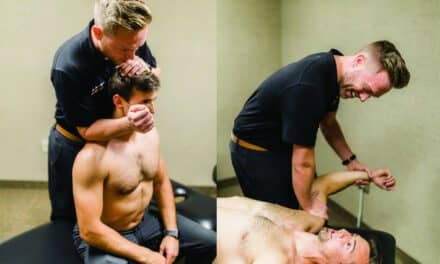A recently developed two-armed, robotic rehabilitation exoskeleton aims to provide a new method of data-driven therapy to patients who have sustained neurological or spinal injuries. The exoskeleton, known as HARMONY, was developed by researchers in the Cockrell School of Engineering at The University of Texas at Austin, according to a university news release.
HARMONY is engineered to deliver full upper-body therapy with natural motion and turnable pressure and force. This is intended to allow the robot to provide a weightless sensation to patients. The release adds that the technology’s software is designed to offer therapists and doctors the ability to deliver precise therapy while tracking and analyzing data.
Watch the rehab robot in action
Researchers say they believe HARMONY may hold promise in helping patients recover strength and motor skills after injuries, and could potentially help patients recover coordination for daily activities such as eating and dressing.
In the release, Ashish Deshpande, PhD, a mechanical engineer researcher who designed the exoskeleton along with a team of graduate students from the Rehabilitation and Neuromsucualr (ReNeu) Robotics Lab, calls the technology a “culmination of years of research and development in the ReNeu Robotics Lab.”
“It was specially designed to offer customized therapy for optimal efficacy. Not only does the exoskeleton adjust to patient size, it can also be programmed to be gentle or firm based on the individual’s therapy needs,” Deshpande adds.
The release states that HARMONY’s design is intended to accommodate the entire upper body. It connects to patients at three places on each side of the upper body and features 14 axes for a wide range of natural motion. The UT Austin research team built and tested the first of several HARMONY prototypes in 2011. The release notes that in 2013, they then worked with Meka Robotics to select the hardware and construct the robot.
The robot features a suite of sensors built to collect data at 2,000 times per second. The data is then fed back into the robot’s program for an instantly personalized robotic interaction. With input from physical therapists and doctors, the release says Cockrell School researchers designed HARMONY’s shoulder mechanism to facilitate natural, coordinated motions, particularly the scapulohumeral rhythm.
HARMONY is also intended to adapt to the specific, corrective ways humans learn. Its high levels of force control and torque control are engineered to gently course correct a patient during an improperly performed robot-guided exercise. HARMONY can also be programmed to gradually increase exercise difficulty levels.
The release reports that with HARMONY’s completion, researchers will continue to develop the software and prepare for an upcoming trial period this summer. Enrollment will begin in June for this study of 20 to 30 healthy subjects, to be conducted at UT Austin.
The researchers reportedly plan to follow it up with a study encompassing stroke and spinal cord injury patients, which will compare HARMONY’s efficacy with conventional rehabilitative therapy.
[Source: Department of Mechanical Engineering, UT Austin]





